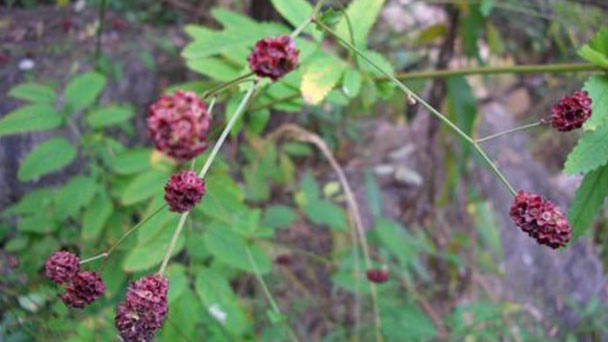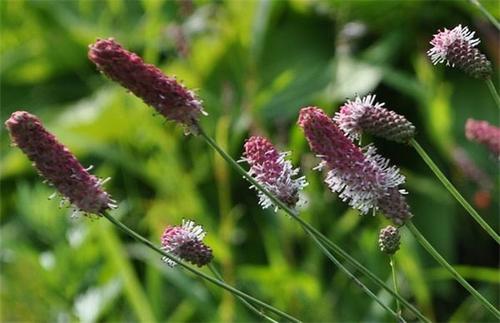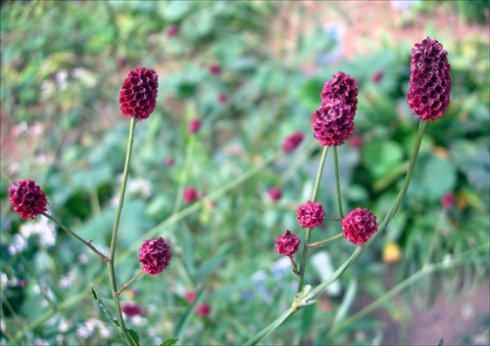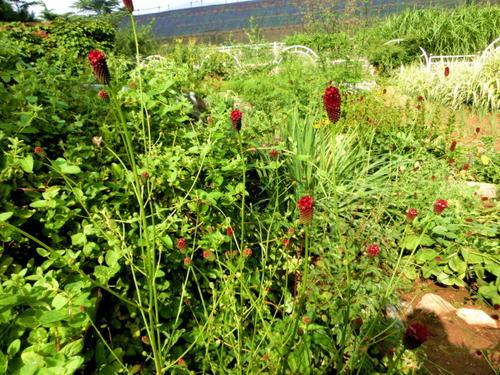Great burnet (Sanguisorba officinalis) profile
Written by admin
Mar 05 2021

Great Burnet (Sanguisorba officinalis L.) is a perennial herb of the genus Great Burnet in the family Rosaceae, having stout, spindle-shaped stalks, short striped-leaflets, purplish red petals, and fruits encrusted in calyx tubes.The Great Burnet is distributed in the north temperate zone of Asia, widely distributed in Europe and China. It grows in the area of 30 meters to 3000 meters above sea level. It is often born in the shrub, grassland, grassland, meadow and open forest on the hillside.
Great Burnet is also a Chinese herb. Cold, bitter and sour taste, non-toxic;Return to liver, lung, kidney and large intestine meridian.Have cool blood to stop bleeding, clear heat and detoxify, peiqing nourish Yin, detumescence collect sores and other effects.
Great burnet picture

Morphological characteristics of the great burnet
Great Burnet is a perennial herb, 30-120 cm tall. Root is stout, spindle shaped, sparse cylindrical, the surface of brown or purplish brown, longitudinal wrinkles and transverse cracks, cross section yellow white or purple red, relatively straight.
Stems of great burnet are erect, angulate, glabrous or with sparse glandular hairs at base. Basal leaves are pinnate compound leaves with 4-6 pairs of leaflets, petioles glabrous or with sparse glandular hairs at the base; Leaves are short petiolate, ovate or oblong-ovate, 1-7 cm long, 0.5-3 cm wide, apex rounded obtuse thinly acute, base cordate to shallow-cordate, margin with many thickly rounded obtuse thinly acute serrates, both surfaces green, glabrous; Cauline leaves less, leaflets have short stalk to few sessile, oblong to oblong lanceolate, narrow, base micro - cordate to round, apex acute; Basal leaf stipules membranous, brown, absent outside, hairy or sparsely glandular, cauline leaf stipules large, herbaceous, semivate, lateral margin sharply serrate.
Inflorescences of Great burnet is elliptic, cylindrical or ovoid, erect, usually 1 -- 3 (4) cm long, 0.5 -- 1 cm transverse, opening downward from apex, pedicels smooth or occasionally sparsely glandular hairy; Bracts are membranous, lanceolate, apically acuminate to caudal, shorter or subequal than sepals, abaxially and margin pilose; Great burnet has 4 sepals, purplish red, elliptic to broadly ovate, abaxially pubescent, central slightly longitudinally ridged, apex often mucronate; Great burnet has 4 stamens, filaments filiform, not enlarged, subequal to sepals or slightly shorter; Ovary is glabrous outside or basally puberulent, stigma tip enlarged, discoid, margin with fimbriate papillae. The fruit is enclosed in the persistent calyx tube and has a baccus outside.
Ecological habits of the great burnet
The Great Burnet is born on sunny slopes, in thickets, and in sandy soils.
The vitality of Great Burnet is vigorous, and the cultivation conditions are not strict. Its underground part is cold resistant, and the aboveground part is high temperature resistant and rainy. Great burnet can be cultivated in all parts of the north and south of China without selecting the soil.
Diseases and pests control of great burnet
Diseases
There is powdery mildew, which starts to occur in spring. The main methods for prevention are to eliminate weeds frequently, plant reasonably close, make the field ventilated and transparent, and avoid excessive humidity.
Insect pests
There are scarab beetles, during the damage with 50% malation 800-1000 times irrigation control larvae.

Species taxonomy of the great burnet
1. Glandular Great Burnet (Variants)
Sanguisorba officinalisl. Var. glandulosa (KOM.) Worosch.
Stems, petioles and peduncles of this variety are more or less pubescent and glandular, with scattered pubescent hairs below the leaves.
Produced in Heilongjiang, Shaanxi, Gansu. Health valley damp forest edge, 630-1820 meters above sea level.It is also found in the Far East of the Soviet Union.
2. Pink Great Burnet (Variants)
Sanguisorba officinalisl. Var. Carnea (Fisch.) Regel ex Maxim.
This variety differs from the original in its pollen red color.
Produced in Heilongjiang and Jilin. North Korea.
The light white calyx was reported as a variant (Journal of Harbin Normal University, Natural Science 1651963).
Its calyx color becomes pale pink, but the middle longitudinal ridge is purple, or the inflorescence is small round head is published as a variant of the light Great Burnet flowers.
3. Long Leaves Great Burnet (Variants)
Sanguisorba officinalisl. Var. Longifolia (Bertol.) Yu et Li
Basal leaflets banded oblong to banded lanceolate, base slightly cordate, rounded to broadly cuneate, cauline leaves many, similar to the basal leaves, but longer and narrow;Spikeles cylindrical, 2-6 cm long, usually 0.5-1 cm in diameter, stamens subequal to sepals.
Produced in Heilongjiang, Liaoning, Hebei, Shanxi, Gansu, Henan, Shandong, Hubei, Anhui, Jiangsu, Zhejiang, Jiangxi, Sichuan, Hunan, Guizhou, Yunnan, Guangxi, Guangdong, Taiwan. Hillside grassland, stream side, thicket, wet grassland and open forest, 100-3000 m.Soviet Siberia, Mongolia, Korea and India are also distributed.
4. Long stamen Great Burnet (variety)
SanguisorbaofficinalisL. var.longifilaKitag.
The varieties with long leaves Great burnetS. OfficinalisL. Var. Longifolia (Bertol.) YuetLi very close, but filaments 4-5 mm long, longer than sepals, 0.5-1 times can be the difference.
Heilongjiang, Inner Mongolia. Raw ditch and grassland wetland, 100-1300 meters above sea level.
The great burnet distribution area
Great Burnet is produced in Heilongjiang, Jilin, Liaoning, Inner Mongolia, Hebei, Shanxi, Shaanxi, Gansu, Qinghai, Xinjiang, Shandong, Henan, Jiangxi, Jiangsu, Zhejiang, Anhui, Hunan, Hubei, Guangxi, Sichuan, Guizhou, Yunnan, Tibet.
Great Burnet grasslands, meadows, hillside grassland, shrubs, sparse forest, 30-3000 meters above sea level.
Great Burnet is widely distributed in Europe and the north temperate zone of Asia.
Great burnet Similar Species
Salad Burnet, Sanguisorba minor, is a much shorter and altogether less spectacular wildflower; it grows in dry calcacareous grassland but has long been cultivated as a kitchen herb for its mild-tasting leaves. Less attractive to insects than its larger, brighter close relative, Salad Burnet relies mainly on the wind to distribute its pollen.
The specimens shown on this page were photographed in East Anglia in summer.

Latest Updated
- Benefits of Bugleweed - 7 Science-backed Health Benefits
- Bugleweed Dangers & Side Effects - Is It Poisonous?
- How to Plant Evergreen Trees - What You Should Know
- When to Plant Evergreens - Grow Guide for Evergreen Trees
- 12 Wonderful Evergreen Shrubs for Your Garden
- 12 Popular Evergreen Plants with Pictures for Beginners
- When And How To Prune A Lilac Bush Like a Pro
- How to Grow & Care for Lilac Vine (Hardenbergia Violacea)
- Japanese Lilac Tree (Syringa Reticulata) Care & Propagation Guide
- Shumard Oak Pros and Cons - What to Know
Popular Articles
- Winter maintenance of Antirrhinum Majus
- How to Grow Terminalia Mantaly Tree
- How to Grow and Care for Crossostephium Chinense
- How to grow Antirrhinum Majus in spring
- Peristeria Elata (Dove Orchid) Profile: Info & Care Guide
- Underwatered Snake Plant (Sansevieria Trifasciata) - Signs And How To Fix
- How to Care for Brazilian Jasmine Plant (Mandevilla Sanderi)
- How to Grow & Care for Graptopetalum Purple Delight in Summer
- Rosa Chinensis (China Rose): Plant Growing & Care Tips
- How to Care for Baby Sun Rose (Aptenia Cordifolia)